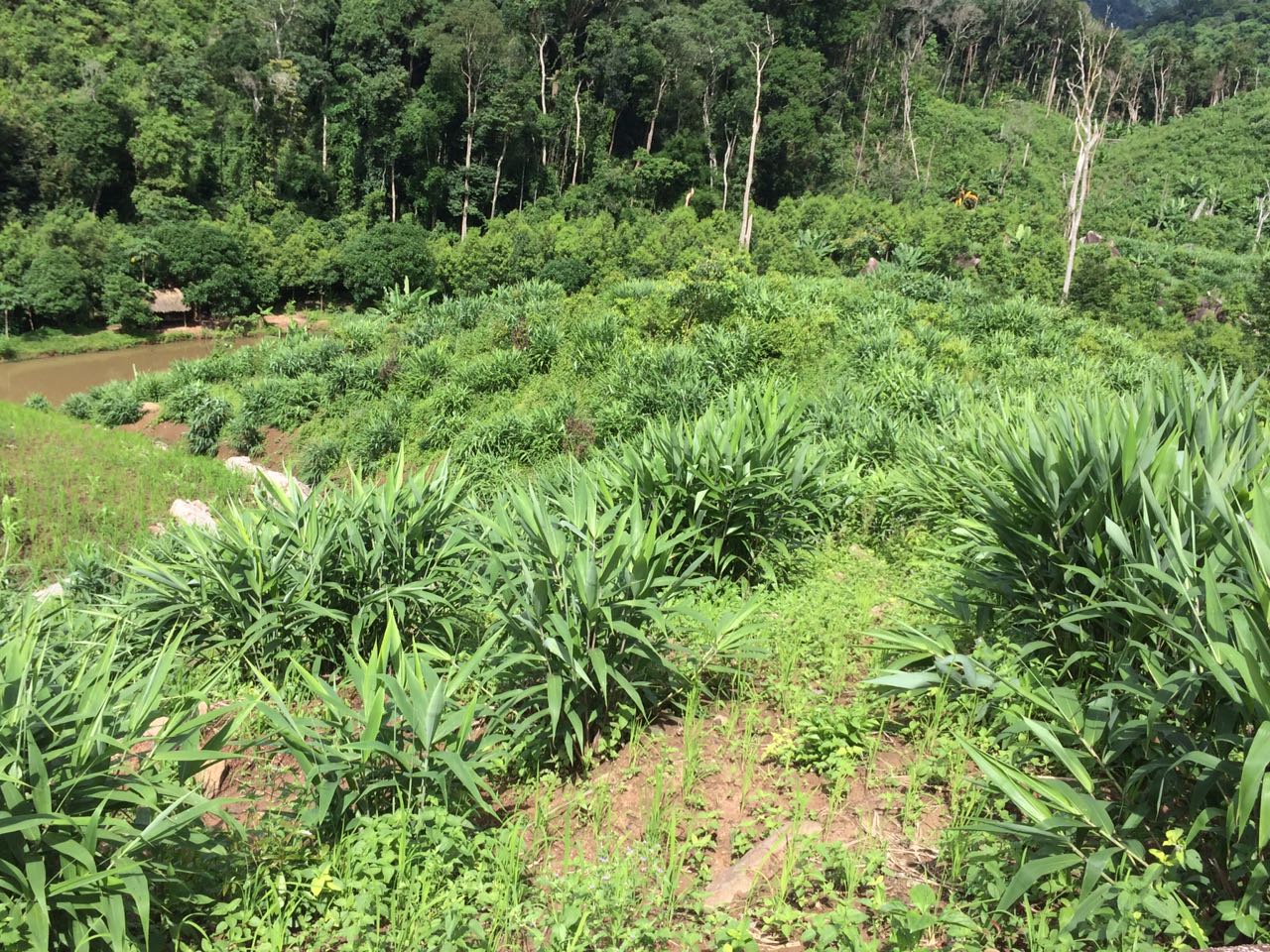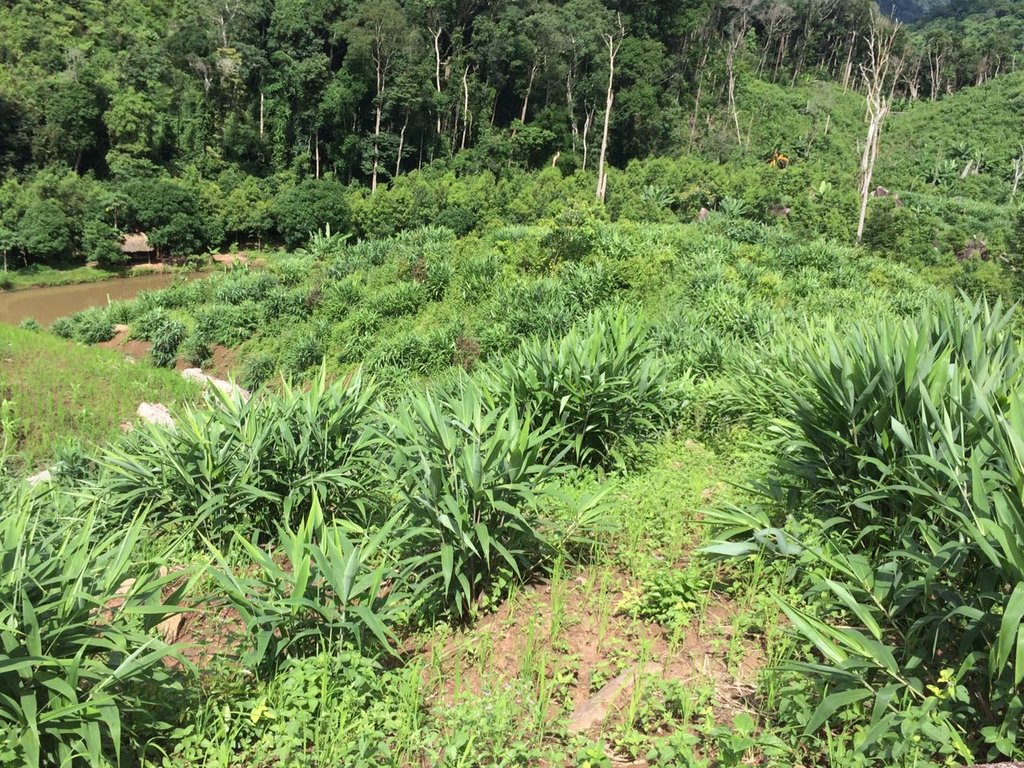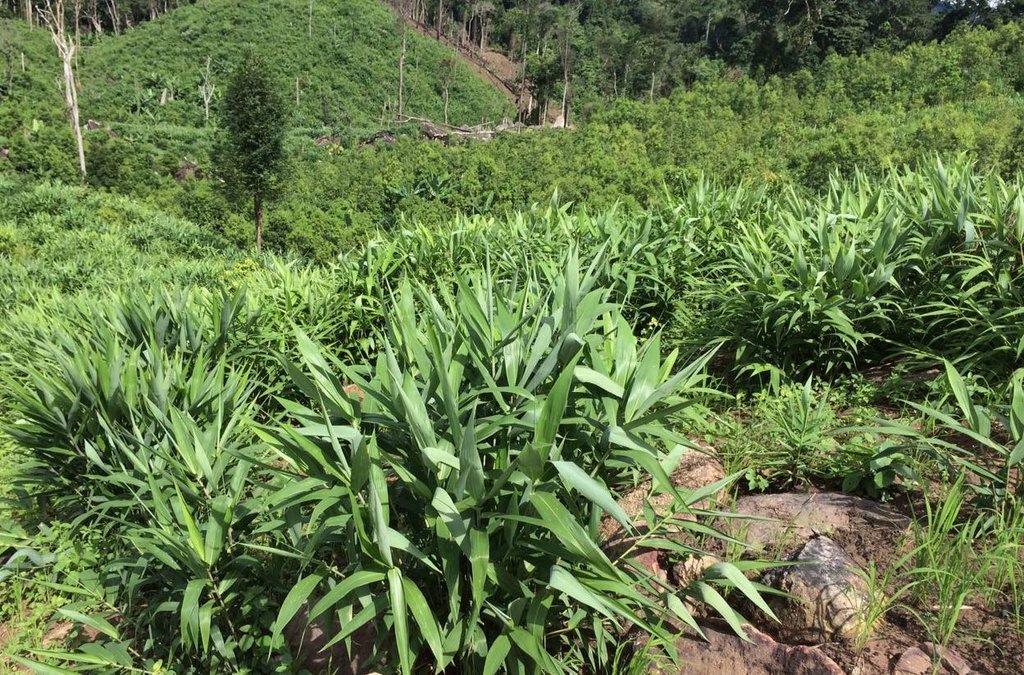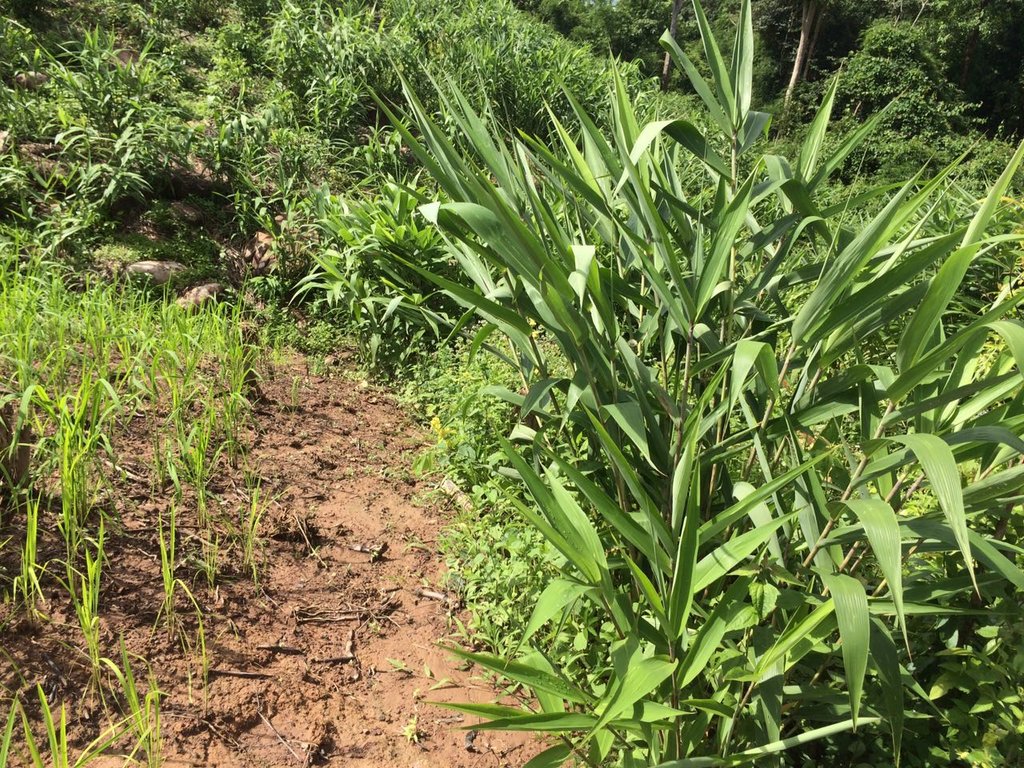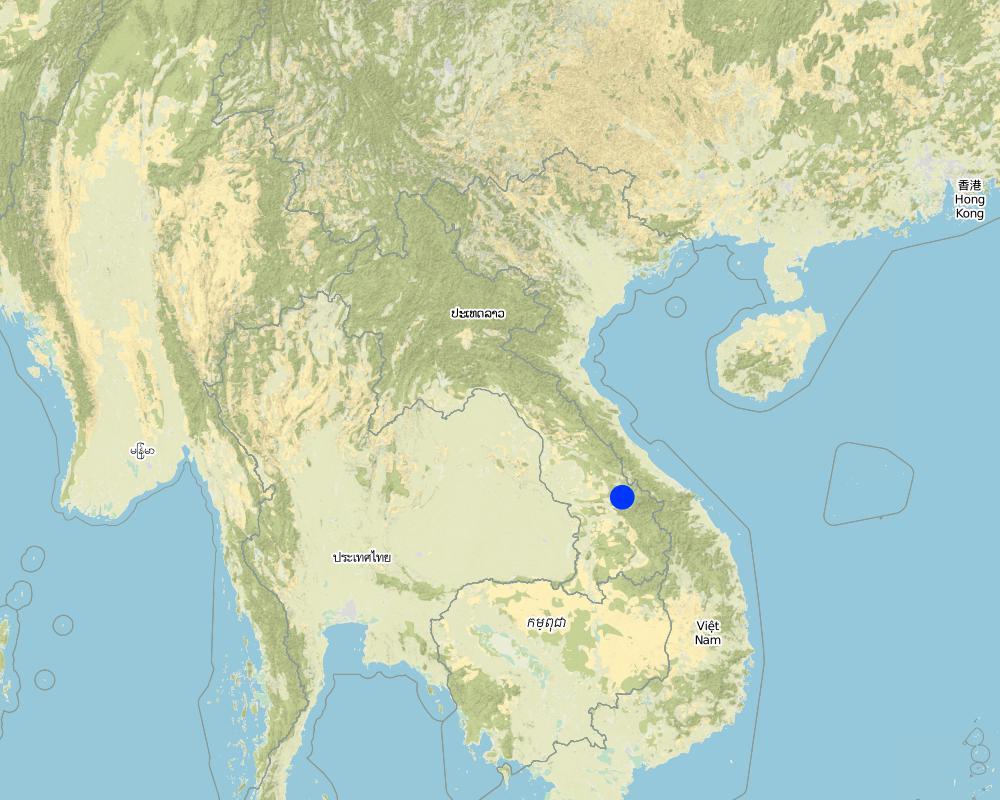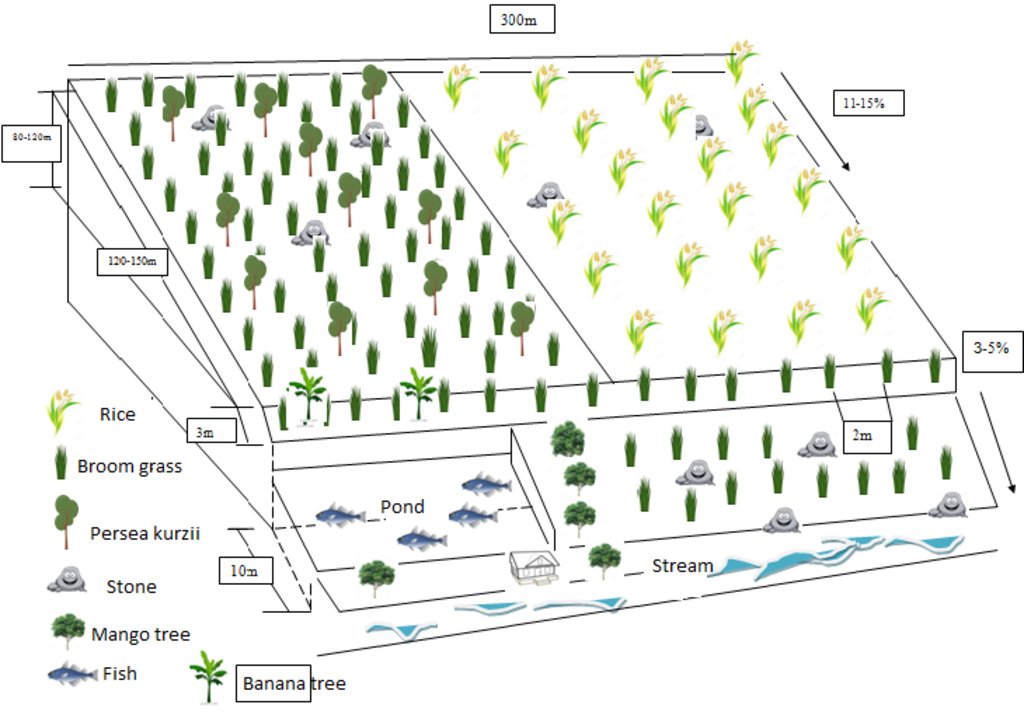Broom grass cultivation to prevent soil erosion in sloping area [Lao People's Democratic Republic]
- Creation:
- Update:
- Compiler: kang phanvongsa
- Editors: Bounthanom Bouahom, Pasalath Khounsy, anousit namsena, kang phanvongsa, THEPPADITH MEUNPANTAVONG
- Reviewers: viengsavanh phimphachanhvongsod, Nicole Harari, Stephanie Jaquet, Alexandra Gavilano
ເຈາະຕັງຕາມຕະກື
technologies_2930 - Lao People's Democratic Republic
View sections
Expand all Collapse all1. General information
1.2 Contact details of resource persons and institutions involved in the assessment and documentation of the Technology
land user:
Phonexay
Lao People's Democratic Republic
Name of project which facilitated the documentation/ evaluation of the Technology (if relevant)
Scaling-up SLM practices by smallholder farmers (IFAD) {'additional_translations': {}, 'value': 6128, 'label': 'Name of the institution(s) which facilitated the documentation/ evaluation of the Technology (if relevant)', 'text': "National Agriculture and Forestry Research Institute (NAFRI) - Lao People's Democratic Republic", 'template': 'raw'}1.3 Conditions regarding the use of data documented through WOCAT
The compiler and key resource person(s) accept the conditions regarding the use of data documented through WOCAT:
Yes
1.4 Declaration on sustainability of the described Technology
Is the Technology described here problematic with regard to land degradation, so that it cannot be declared a sustainable land management technology?
No
2. Description of the SLM Technology
2.1 Short description of the Technology
Definition of the Technology:
The technique involves the planting of broom grass in order to prevent landslide in mountainous and stream areas which are adjacent to agricultural land. This is because broom grass has an extensive root system which can help to bind the soil. Additionally, farmers can generate an income from broom grass.
2.2 Detailed description of the Technology
Description:
Climate change has impacted agricultural practices and the livelihoods in rural mountain areas. Due to the occurrence of more volatile climate conditions including more frequent and intense rainfall in July and August, it has affected soil erosion on steep slopes. Therefore, broom grass was introduced to help stabilize soil composition and to prevent erosion and landslide.
In 2011 farmers at Chorlaving village, Ta-oy district started the technology by taking the broom grass rhizomes from the natural forest and replanting these on their own land which had been impacted by soil erosion. Their main objective was to prevent landslides that could impact their crops. At the same time it is also easier to manage and harvest broom grass on their land, which will be sold to merchants coming to the village. Most importantly, broom grass - a native species - has an extensive root system into a depth of 1 – 2 meters that helps to bind the soil. Furthermore it is highly adaptive to local climatic and environmental conditions and is seldom affected by diseases or becomes a food source for animals (as its leaves are hairy and rough). For the collection of broom grass rhizomes simple equipment is needed. This includes blades, knifes and baskets. The rhizomes should be selected along steep slopes in mountainous areas. Then the stems are removed from the parent plants, whole young plant is removed including the root and culms of about 30 cm. The broom grass plantation of this case study area has a length of 300 meters and a width of 80 – 120 meters on a sloping terrain with a gradient between 11-15%. The seedlings can be grown from healthy rhizomes collected in local forest areas, with approximately 6,000 seedlings per hectare. They are usually planted in April and May when the soil is still warm and stimulates the growth. To start off with, the farmers need to collect broom grass rhizomes from forest areas for one or two days. Afterwards they should be maintained for few days in a well shaded area, watered and covered by plastic bags. Land preparation firstly involves bush clearance. After, the farmers create rows by digging 20 x 20 cm holes at a distance of approx. 2 meters from one hole to the next. Planting may commence at the bottom of the field with the farmer placing 4 – 5 rhizomes in each freshly dug hole as he moves upward the row following the contour of the land. Yangbong trees, but also other plants can be intercropped in every two rows of broom grass. The grass helps to retain soil moisture which promotes e.g. the Yangbong trees’ growth. Once a year the broom grass area needs weeding and thinning. After harvest of the grass the cuttings and fragments can be used for mulching the soil surface around the broom grass stems and the trees. This not only retains soil moisture, but by the decaying process it enriches the soil by nutrients (natural compost).Typically, broom grass can be harvested 2 – 3 years after it has been planted. During the rainy season (June to October), the roots and the new shoots of broom grass grow quickly. The strengths of a broom grass plantation are that firstly it prevents soil erosion and secondly its different elements (e.g. flowers) which provide a higher household income. Model farmer’s broom grass plantation is 1.5 ha and may generate an income of around 2,000,000 Kip/ton/year. Currently, broom grass can be used for handicrafts, household products such as brooms and can also be sold to neighboring countries. There are currently many households engaged in planting broom grass for commercial purposes on their own land. This reduces conflicts among the village people araising when it had to be collecte in natural areas.
Weaknesses: The root system of broom grass grows quickly which may result in the competition for nutrients and space with the other crops. Therefore appropriate management may be required by cutting and removing excessive rhizomes and culms. Furthermore, the roots can expand so extensively (difficult to remove when they grow up) that it would exceed the farmer’s capacity to control them in order to get enough space for inter-crops. And planting broom grass on sloping terrain may cause difficulties to maintain and harvest the crop.
2.3 Photos of the Technology
2.5 Country/ region/ locations where the Technology has been applied and which are covered by this assessment
Country:
Lao People's Democratic Republic
Region/ State/ Province:
Ta-oy district, Salavan province
Further specification of location:
Chorlaveing village
Specify the spread of the Technology:
- evenly spread over an area
If precise area is not known, indicate approximate area covered:
- < 0.1 km2 (10 ha)
Map
×2.6 Date of implementation
Indicate year of implementation:
2011
If precise year is not known, indicate approximate date:
- less than 10 years ago (recently)
2.7 Introduction of the Technology
Specify how the Technology was introduced:
- through land users' innovation
3. Classification of the SLM Technology
3.1 Main purpose(s) of the Technology
- reduce, prevent, restore land degradation
- conserve ecosystem
- reduce risk of disasters
- create beneficial economic impact
- create beneficial social impact
3.2 Current land use type(s) where the Technology is applied

Cropland
- Perennial (non-woody) cropping
Number of growing seasons per year:
- 1
Comments:
Main crops (cash and food crops): Broom grass, Nothaphoebe umbelliflora
3.4 Water supply
Water supply for the land on which the Technology is applied:
- rainfed
3.5 SLM group to which the Technology belongs
- rotational systems (crop rotation, fallows, shifting cultivation)
- improved ground/ vegetation cover
3.6 SLM measures comprising the Technology

agronomic measures
- A1: Vegetation/ soil cover

vegetative measures
- V2: Grasses and perennial herbaceous plants

management measures
- M5: Control/ change of species composition
3.7 Main types of land degradation addressed by the Technology

soil erosion by water
- Wt: loss of topsoil/ surface erosion
- Wg: gully erosion/ gullying
- Wr: riverbank erosion
- Wo: offsite degradation effects
3.8 Prevention, reduction, or restoration of land degradation
Specify the goal of the Technology with regard to land degradation:
- prevent land degradation
- reduce land degradation
4. Technical specifications, implementation activities, inputs, and costs
4.1 Technical drawing of the Technology
Technical specifications (related to technical drawing):
The area have 300 m length , 80 m - 120 m width
- Space between plants is 2 x 2 m, 4-5 rhizomes per plant hole.
- Slope angle 11-15% , for foot slope is 3-5%. Protected area (protected area on foot slope along the cultivation area is 3 m)
- Equipment: knife, spade, basket for rhizom collection ond digging wholes
- Broom grass species are taken from natural forsts by cutting the rhizome include some stems.
- Density of plants is 6000 seedling/ha
The native broom grass species that can be cultivated in almost all types of soil. This species has long leaves (60-80cm) can play as a shelter from direct sunlight into the soil, and the erect culms can reach a length of 1.5 - 2 meters. One clump of broom grass would typically have between 10-20 culms. The land that was previously used for shifting cultivation has recently been planted with (Persea kuzii) Yangbong intercropped with broom grass. Now there is an expansion upland rice area next to the broom grass and the Yangbong plantation, this enables the farmer to grow rice intercropped with broom grass in the new area for first year after broom grass plantation, then rotate rice cultivation in previous area where Yangbong and broom grass will be harvest. Actually, in this model the farmer has two plots – one plot has been cultivated since 2011 consisting of predominantly broom grass and there is also Yanbong, whilst the other plot has only broom grass since 2012 and then planted Yangbong in 2015. Furthermore he planted other fruit trees and created a fishpond at the bottom of the broom grass plantation. This is because the culms which grow closely together help to block sediment run-off into the fishpond. Previously this area was used to grow rice, Yangbong and other fruit trees, after rice harvesting and Yangbong cutting, the broom grass was used before upland rice cultivation again and it is surrounded by several big stones and rocks.
Author:
Phonesyli Phanvongsa
Date:
11/07/2017
4.2 General information regarding the calculation of inputs and costs
Specify how costs and inputs were calculated:
- per Technology area
Indicate size and area unit:
3 ha
If using a local area unit, indicate conversion factor to one hectare (e.g. 1 ha = 2.47 acres): 1 ha =:
Length 300 meters, width 100 meters
other/ national currency (specify):
kip
If relevant, indicate exchange rate from USD to local currency (e.g. 1 USD = 79.9 Brazilian Real): 1 USD =:
8400.0
Indicate average wage cost of hired labour per day:
50,000 kip
4.3 Establishment activities
| Activity | Timing (season) | |
|---|---|---|
| 1. | Land preparation | 30 days before onset of rain |
| 2. | Collection of broom grass | |
| 3. | Digging holes and planting |
4.4 Costs and inputs needed for establishment
| Specify input | Unit | Quantity | Costs per Unit | Total costs per input | % of costs borne by land users | |
|---|---|---|---|---|---|---|
| Labour | Labor for land preparation | Person-day | 3.0 | 50000.0 | 150000.0 | 100.0 |
| Labour | Labor for collection of broom grass seedlings | Person-day | 3.0 | 50000.0 | 150000.0 | 100.0 |
| Labour | Labor for digging holes and planting | Person-day | 3.0 | 50000.0 | 150000.0 | 100.0 |
| Equipment | Spade | Piece | 4.0 | 15000.0 | 60000.0 | 100.0 |
| Equipment | Knife | Piece | 4.0 | 25000.0 | 100000.0 | 100.0 |
| Equipment | Basket | Piece | 4.0 | 50000.0 | 200000.0 | 100.0 |
| Total costs for establishment of the Technology | 810000.0 | |||||
| Total costs for establishment of the Technology in USD | 96.43 | |||||
4.5 Maintenance/ recurrent activities
| Activity | Timing/ frequency | |
|---|---|---|
| 1. | weeding | annually |
| 2. | cut out dead stems | annually |
4.6 Costs and inputs needed for maintenance/ recurrent activities (per year)
| Specify input | Unit | Quantity | Costs per Unit | Total costs per input | % of costs borne by land users | |
|---|---|---|---|---|---|---|
| Labour | Labor for weeding and cut out dead stems | Person | 4.0 | 50000.0 | 200000.0 | 100.0 |
| Total costs for maintenance of the Technology | 200000.0 | |||||
| Total costs for maintenance of the Technology in USD | 23.81 | |||||
4.7 Most important factors affecting the costs
Describe the most determinate factors affecting the costs:
Labor is the most important factor affecting the costs
5. Natural and human environment
5.1 Climate
Annual rainfall
- < 250 mm
- 251-500 mm
- 501-750 mm
- 751-1,000 mm
- 1,001-1,500 mm
- 1,501-2,000 mm
- 2,001-3,000 mm
- 3,001-4,000 mm
- > 4,000 mm
Specify average annual rainfall (if known), in mm:
450.00
Specifications/ comments on rainfall:
Heavy rains is occur in July - August
Indicate the name of the reference meteorological station considered:
Ta-oy District Agriculture and forest Technical Service Center
Agro-climatic zone
- humid
5.2 Topography
Slopes on average:
- flat (0-2%)
- gentle (3-5%)
- moderate (6-10%)
- rolling (11-15%)
- hilly (16-30%)
- steep (31-60%)
- very steep (>60%)
Landforms:
- plateau/plains
- ridges
- mountain slopes
- hill slopes
- footslopes
- valley floors
Altitudinal zone:
- 0-100 m a.s.l.
- 101-500 m a.s.l.
- 501-1,000 m a.s.l.
- 1,001-1,500 m a.s.l.
- 1,501-2,000 m a.s.l.
- 2,001-2,500 m a.s.l.
- 2,501-3,000 m a.s.l.
- 3,001-4,000 m a.s.l.
- > 4,000 m a.s.l.
Indicate if the Technology is specifically applied in:
- convex situations
5.3 Soils
Soil depth on average:
- very shallow (0-20 cm)
- shallow (21-50 cm)
- moderately deep (51-80 cm)
- deep (81-120 cm)
- very deep (> 120 cm)
Soil texture (topsoil):
- fine/ heavy (clay)
Soil texture (> 20 cm below surface):
- fine/ heavy (clay)
Topsoil organic matter:
- medium (1-3%)
5.4 Water availability and quality
Ground water table:
5-50 m
Availability of surface water:
good
Water quality (untreated):
for agricultural use only (irrigation)
Is water salinity a problem?
No
Is flooding of the area occurring?
No
5.5 Biodiversity
Species diversity:
- medium
Habitat diversity:
- medium
5.6 Characteristics of land users applying the Technology
Sedentary or nomadic:
- Sedentary
Market orientation of production system:
- commercial/ market
Off-farm income:
- less than 10% of all income
Relative level of wealth:
- average
Individuals or groups:
- individual/ household
Level of mechanization:
- mechanized/ motorized
Gender:
- women
- men
Age of land users:
- youth
- middle-aged
5.7 Average area of land used by land users applying the Technology
- < 0.5 ha
- 0.5-1 ha
- 1-2 ha
- 2-5 ha
- 5-15 ha
- 15-50 ha
- 50-100 ha
- 100-500 ha
- 500-1,000 ha
- 1,000-10,000 ha
- > 10,000 ha
Is this considered small-, medium- or large-scale (referring to local context)?
- large-scale
5.8 Land ownership, land use rights, and water use rights
Land ownership:
- individual, titled
Land use rights:
- individual
Water use rights:
- open access (unorganized)
- individual
5.9 Access to services and infrastructure
health:
- poor
- moderate
- good
education:
- poor
- moderate
- good
technical assistance:
- poor
- moderate
- good
employment (e.g. off-farm):
- poor
- moderate
- good
markets:
- poor
- moderate
- good
energy:
- poor
- moderate
- good
roads and transport:
- poor
- moderate
- good
drinking water and sanitation:
- poor
- moderate
- good
financial services:
- poor
- moderate
- good
6. Impacts and concluding statements
6.1 On-site impacts the Technology has shown
Socio-economic impacts
Production
crop production
Comments/ specify:
Increase in crop production such as upland rice because broom grass can protect them from rainstorm damage leading to better rice yield.
Income and costs
farm income
Comments/ specify:
Previously: Very low income from scarse broom grass collection in natural forests. After broom grass cultivation: the farmer gets around 2,000,000 Kip/ton.
diversity of income sources
Comments/ specify:
Previously: the range of products to be sold on the market was small, insecure and its quantity very low (small income from banana, rice, pineapple). After broom grass cultivation: Broom grass generates further and even main income. And because it protects also the fish pond below the slope area, fish can be a further income source.
workload
Comments/ specify:
Before, it took many days to harvest the broom grass from the natural forest, as it was far away from the village. After broom grass cultivation: It is easy to harvest the broom grass (Maintenance is not labour-intensive compared to the situation before).
Socio-cultural impacts
conflict mitigation
Comments/ specify:
Because there is a limited abundance of natural broom grass in the natural forests collection has repeatedly caused conflicts among village's people. After: Many of them have now their individual areas for broom grass harvesting which reduced the conflict potential.
Ecological impacts
Water cycle/ runoff
surface runoff
Comments/ specify:
Previously: decreased vegetation on slope area and abundance of mulching promoted heavy surface runoff accompagnied by soil erosion and accumulation mainly on foot slopes and river banks. After: The root system of broom grass and the mulching improved the soil surface structure that enhanced the water infiltration and absorption during heavy rains.
Soil
soil moisture
Comments/ specify:
Previously: Less vegetation cover exposed soil to sunlight which fastly dries up the soil . After: Broom grass have many leaves and their detritus (mulch of dead leaves and stems ) covers soil surface and make soil more moist
soil loss
Comments/ specify:
Broom grass can minimize soil loss by their root system and detritus cover soil surface when there heavy rain occurs.
soil accumulation
Comments/ specify:
Before: Without barrier and improved soil cover the soil sediments in the storm water runoff were washed directly into the stream. After: the heavy runoff is hampered by better soil cover that retain soil. Additionally, the plant detritus provides material for further soil formation.
nutrient cycling/ recharge
Comments/ specify:
After Broom grass cultivation the detritus has been increased which improves the nutrient status of soil and provides nutrients to the soil and its organisms.
Climate and disaster risk reduction
landslides/ debris flows
Comments/ specify:
The dense and expanded cover of broom grass with its deep roots are able to reduce landslides in the watershed.
6.2 Off-site impacts the Technology has shown
downstream siltation
Comments/ specify:
Density of broom grass is playing a significant role as a filter to reduce downstream siltation
6.3 Exposure and sensitivity of the Technology to gradual climate change and climate-related extremes/ disasters (as perceived by land users)
Gradual climate change
Gradual climate change
| Season | increase or decrease | How does the Technology cope with it? | |
|---|---|---|---|
| seasonal rainfall | wet/ rainy season | increase | very well |
6.4 Cost-benefit analysis
How do the benefits compare with the establishment costs (from land users’ perspective)?
Short-term returns:
slightly negative
Long-term returns:
very positive
How do the benefits compare with the maintenance/ recurrent costs (from land users' perspective)?
Short-term returns:
neutral/ balanced
Long-term returns:
neutral/ balanced
6.5 Adoption of the Technology
- 11-50%
Of all those who have adopted the Technology, how many did so spontaneously, i.e. without receiving any material incentives/ payments?
- 91-100%
6.6 Adaptation
Has the Technology been modified recently to adapt to changing conditions?
No
6.7 Strengths/ advantages/ opportunities of the Technology
| Strengths/ advantages/ opportunities in the land user’s view |
|---|
| Broom grass roots penetrate deeply into the the soil and are able to hold the soil together leading to prevent soil erosion. |
| In this region other plants and crops can be intercropped within the Broom grass cultivation area. |
| Broom grass improves the income for household. |
| Strengths/ advantages/ opportunities in the compiler’s or other key resource person’s view |
|---|
| Broom grass can reduces surface runoff during heavy rains. |
| Detritus of broom grass increases the biomass on topsoil and promotes organic matter and nutrients for the plants. |
6.8 Weaknesses/ disadvantages/ risks of the Technology and ways of overcoming them
| Weaknesses/ disadvantages/ risks in the land user’s view | How can they be overcome? |
|---|---|
| Broom grass roots can expand extensively and can result in competition with other crops, respectively the roots may invade soil space for inter-cropping. | Attentive and good management by cutting some parts of them |
| Broom grass on a sloping terrain may make it difficult to maintain and harvest the crop. |
7. References and links
7.1 Methods/ sources of information
- field visits, field surveys
1 time
- interviews with land users
2 persons
When were the data compiled (in the field)?
11/07/2017
Links and modules
Expand all Collapse allLinks
No links
Modules
No modules


